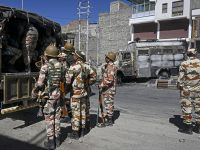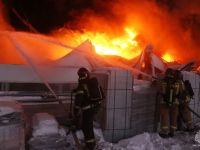Although Morocco has limited energy resources, the country is a major phosphate producer, as well as an important transit center for natural gas exports from Algeria to Europe.
Please note - Information contained in this report is the best available as of February 2000 and is subject to change. Since then Morocco discovered what seems to be seen as substantial quantities of oil, however checks and approval tests still continue.
General Background:
King Hassan II, ruler of Morocco since 1961, died on July 23, 1999, and was succeeded by his son, Mohammad VI. As of early 2000, the new King generally has continued his father's policies, and is an advocate of economic reform and political liberalization.
Morocco's real gross domestic product is expected to grow by around 4.5 percent in 2000 (up from 1.5 percent growth in 1999, when it was hurt by a serious drought). Agriculture, which makes up a large share (around 17 percent -20 percent) of Morocco's economy and workforce (around 40 percent -50 percent), is heavily dependent on rainfall patterns, and is subject to serious droughts.
The vulnerability that this implies for Morocco's economy has encouraged the government in its attempts at economic diversification, particularly towards manufacturing and services (including tourism). Morocco has a strong tourism sector plus an expanding manufacturing base (manufacturing now makes up around 17 percent of Morocco's economy).
Morocco maintains relatively tight fiscal and monetary policies, and this has helped reduce the country's fiscal deficit from 10 percent of GDP in the 1980s to less than 3 percent currently. Monetary policy was relaxed somewhat during 1999 in order to stimulate economic growth, but could begin to tighten in response to increased inflationary pressures during 2000.
Morocco's inflation rate (consumer prices) is expected to average around 4.4 percent in 2000, up from 2.9 percent in 1999, in part because of higher food and energy prices (the government is increasing subsidies to cushion the impact of oil price increases). The country's trade deficit should be reduced slightly, to around $3.4 billion, from $3.3 billion in 1999 (Morocco traditionally runs a merchandise trade deficit and a surplus on transfers -- largely from worker remittances).
Finally, foreign investment, which had declined sharply in 1998, picked up again in 1999, partly in response to government policies aimed at creating a positive environment for such investment. Morocco attracted around $1.9 billion in foreign investment in 1999.
Morocco has begun a new five-year economic plan, which runs from 1999-2004. The plan calls for promoting job creation (unemployment is a serious problem in Morocco), exports and tourism, accelerating the country's privatization process (which as of late 1999, had seen 60 companies privatized since the program was launched in 1993), upgrading of infrastructure, and reducing social inequalities (especially between urban rich and rural poor).
Morocco has almost no energy reserves, but does contain the world's largest phophate reserves, and produces significant amounts of fertilizers and phosphoric acid. Morocco imports around 90 percent of its energy needs, including significant amounts of oil and coal. The government is encouraging increased coal and hydroelectricity production. Coal imports and phosphate exports travel largely through the deepwater port of Jorf Lasfar, which is also the site of a $1-billion phosphoric acid plant and a coal-fired power plant.
A referendum on the future of the Western Sahara, a former Spanish colony in dispute between Morocco and the Polisario national liberation group, was scheduled to be held in January 1992 under U.N. auspices, but has yet to be carried out. In December 1999, the U.N. Security Council voted to keep the U.N. mission in Western Sahara through February 2000. On February 18, 2000, U.N. Secretary General Kofi Annan stated that the core problem of determining who is eligible to vote on the question of independence for the Western Sahara region "could...prevent the holding of the referendum" indefinitely.
Oil & Gas:
Until recently Morocco contained no significant proven oil, although most sedimentary basins in the country have not been explored, and relies on imports for all of its oil needs. In 1999, despite efforts by Morocco's energy minister to attract foreign investors to explore for oil and gas, only a few companies signed agreements.
These included Saudi Aramco, Australia's ROC, Sweden's Taurus, and U.S.-based Skidmore, which reportedly will invest $50 million in oil exploration onshore in Ounara, on the Atlantic Coast near Essaouira. Lasmo already has a concession at the Ras Tafalney block, located offshore the coastal town of Essaouira.
The block is similar geologically to large hydrocarbon basins off Angola, Congo, and Nigeria. Morocco has oil shale deposits in the Atlas Mountains, but these have not been exploited for economic reasons. Morocco produces small volumes of natural gas from the Gharb Basin in the north, and appears to have a considerable gas field at Meskala just north of Essaouira.
In January 2000, an energy ministry spokesman said that Morocco would soon issue new tax ememptions and other incentives to help attract foreign investors to explore for oil in Morocco. In late December 1999, Morocco's Parliament unanimously adopted a new hydrocarbon law, which, among other things, would offer a 10-year tax break to offshore oil production firms and reduce the government's stake in future oil concessions (to a maximum of 25 percent).
In October 1998, IPIC and Cepsa formed a 50-50 joint venture called Cepsa Maghreb to market and distribute petroleum products and Liquefied Petroleum Gas (LPG) in Morocco. Products are to be supplied from Cepsa's refineries in Spain, and French company Vitogaz is building an LPG import terminal and tank farm near Casablanca. Meanwhile, Spanish oil and gas group Repsol has announced its intentions to invest $20 million in Morocco's energy sector over the next 5 years.
Morocco has two refineries and consumes 145,000 barrels per day (bbl/d) of oil. Two refining companies -- Samir and SCP -- agreed in late 1998 to merge as of the first quarter of 1999. The two companies, which are owned largely by Corral Petroleum Holding of Sweden, have a combined refining capacity of around 156,000 bbl/d. In July 1998, Samir announced that it was planning to invest around $500 million in various oil projects, including increased output at its 125,000-bbl/d refinery at Mohammedia (near Casablanca).
Although it contains only small natural gas reserves of its own, Morocco is a major transit center for Algerian gas exports across the Strait of Gibraltar to Spain, via the 300-billion-cubic-foot-per-year Maghreb-Europe Gas (MEG) pipeline. In November 1999, Spanish company Natural Gaz SDG announced its intention to invest up to $400 million in a natural gas distribution network for Morocco.
Coal & Electricity:
Morocco produces coal from its one mine at Jerada, and imports coal from the United States, Colombia, and South Africa. Coal is consumed largely by power plants at Mohammedia and Jorf Lasfar.
With electricity demand increasing around 7 percent annually, Morocco plans to expand the Jorf Lasfar plant with the addition of two 330-megawatt (MW) units on a build-operate-transfer (BOT) basis. Mohammedia is supplied through the port of Casablanca, which has been stretched to its limits by increased coal imports.
Morocco's National Office of Electricity (ONE) has an ambitious plan to supply the countryside with electricity by 2010 (currently, only around 15 percent of the rural population has access to electricity). Morocco plans to spend around $3.7 billion on energy projects through 2003, and part of this money will go towards building power plants and towards rural electrification.
As part of this plan, a new, $500-million, 350-400-MW combined-cycle power plant, to be fired by natural gas from the MEG pipeline, is planned. The plant, Morocco's third independent power project (IPP), is to be built at Tahaddart, near Tangier in northern Morocco, with the first stage operational by 2002 and the second stage completed by 2004. As of early 2000, three energy consortia reportedly were competing for the project: Germany's Siemens; General Electric; and a group led by ABB Alsthom.
ONE also is looking at solar power, as well as at building wind power parks throughout the country (including farms at Tangier and Tarfaya). In late 1998, ONE awarded a $56-million construction contract to a French joint venture (CED) for a 50-MW wind farm to be built at Koudia el Beida near the Straight of Gibraltar. If completed, this would be the first wind farm in Africa and the Arab world, according to ONE. In September 1998, Endesa signed a deal with ONE to supply Morocco with 300 gigawatt hours of electricity through November 1998. Meanwhile, a potential project to build a 50-MW solar power plant at Ouarzazate has been postponed. Morocco also is interested in nuclear power for desalination and other purposes, but currently has no nuclear plants.
ANNEX
ENERGY OVERVIEW
Proven Oil Reserves (1/1/00E): 1.9 million barrels – this number will be changed probebly in the near future.
Crude Oil Production (1998E): 1,000 barrels per day (bbl/d)
Oil Consumption (1998E): 145,000 bbl/d
Net Oil Imports (1998E): 144,000 bbl/d
Crude Refining Capacity (1/1/00E): 156,630 bbl/d
Natural Gas Reserves (1/1/00E): 49 billion cubic feet (Bcf)
Natural Gas Production/Consumption (1997E): 1.4 Bcf
Recoverable Coal Reserves (12/31/96): 6 million short tons (Mmst)
Coal Production (1998E): 0.4 Mmst
Coal Consumption (1998E): 3.5 Mmst
Net Coal Imports (1998E): 3.1 Mmst
Electric Generation Capacity (1/1/98E): 4.0 gigawatts (75 percent thermal, 25 percent hydroelectric)
Electricity Generation (1998E): 13.2 billion kilowatthours (bkwh)
Oil & Gas Industries
Organization: Office Nationale de Recherches et d'Exploitation Petrolieres (ONAREP) is the national (upstream) oil company.
Major Oil Fields: None
Refineries (capacity-bbl/d): Samir -- Mohammedia (125,230); Ste. Cherifienne des Petroles -- Sidi Kacem (31,400)
Ports: Jorf Lasfar, Casablanca
Pipelines: The Maghreb-Europe Gas (MEG) pipeline passes through Morocco from Algeria en route to Spain.
Major Foreign Energy Company Involvement: Cepsa, Lasmo, Mobil, Repsol, Shell, Total
Source:United States Energy Information Administration.
© 2000 Mena Report (www.menareport.com)







